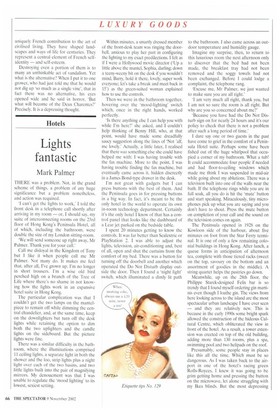Sinking spirits
Thomas Cussons
TO say that there is a crisis in the Cognac world is to understate the case, The word scarcely hints at the sorry spectacle that is unfolding. This is more than just a tale of falling sales and mounting stocks, though the extent of the industry's financial woes are real enough. More than anything, the crisis looks set to alter dramatically the fabric of the Deux Charentes, the two departements north of Bordeaux where Cognac is produced.
Cognac is more than just the economic heart of the Deux Charentes; it effectively is the Deux Charentes — and has been for several hundred years. It is by far the region's largest business, directly employing 22,000 people and indirectly employing a further 33,000 out of a total population of 880,000. As significant, Cognac accounts for 25 per cent of all sales in the region and a whopping 70 per cent of its exports. And this in an area that remains among the poorest in France, with an unemployment rate obstinately stuck in double figures.
Of course, even in its current gloomy condition, Cognac is still big business. In 2000, exports topped eight billion francs, more than £800 million. They account for close on 20 per cent of the value of all French exports of wines and spirits, and a hefty two-thirds of all French exports of spirits.
But not even the most optimistic can deny that there has been a frightening downturn. Since 1990, sales have declined by almost a quarter, from a high of 155 million bottles a year to 119 million bottles last year. Even more to the point has been the collapse in the sales of quality or XO Cognacs, which have tumbled from 80 million bottles a year 12 years ago to just under 50 million last year. Given that a single bottle of X0 Cognac can produce the same revenues as ten bottles of cheaper Cognacs, the impact has been inevitable.
The most obvious reason for the crisis has been what many refer to as the Japanese meltdown'. In the late 1980s, Cognac sales to Japan soared. It wasn't just a question of volume but of quality. Drinking Cognac for the Japanese became an ideal expression of the country's new status-driven buying power. By the early 1990s, with the market at its peak, 75 per cent of Japanese Cognac imports were of the superior XO Cognacs, a figure that compares with the global average of 45 per cent. That the country's punitive import duties could push the price of a top bottle close to 10,000 francs (£1,000) only added to the lure. The more expensive it was, the more Japanese wanted it. In six years, sales leapt from 12 million bottles to 27 million bottles a year.
The collapse was abrupt and alarming. Within five years, sales had dropped by 50 per cent. By 2001, they had fallen to six million bottles.
On the face of it, the reason for this calamitous downturn is obvious. At least in part, sales of Cognac are an almost infallible barometer of global economic activity. Given that 93 per cent of all sales are exports, and that Cognac is by definition a luxury product, any upturn in economic activity almost anywhere in the world has historically been accompanied by an upturn in Cognac sales. Japan was a classic case. As the country boomed, sales soared. As it hit the economic buffers, they slumped. Given this, it would be reasonable to expect that the more or less healthy state of the world economy over the last ten years — Japan apart — should have seen sales at least holding steady. Yet the decline has continued, Why?
The answer has profound implications for the industry. Put simply, the world seems to be losing its taste for Cognac. In part, this is the natural result of more competition and greater consumer choice. The explosion in the variety of single malt whiskies, exotic vodkas and other once little-known spirits that have become available over the last ten years has been dramatic. In such an infinitely more varied and sophisticated market, it's inevitable that Cognac's pre-eminence as the 'king of spirits' should be squeezed.
But there is a sense, too, that Cognac has contributed to its own downfall. For years, the drink sold itself as the ultimate digestif, an after-dinner drink for connoisseurs of haute cuisine, preferably accompanied by a cigar the size of a small airship. This image of heavy-jowled, well-fed masculinity may once have been among Cognac's most potent trump cards. Today it is glaringly out of step with a fashion-led, health-conscious market. As almost anyone in the luxury-drinks business will confirm, the overwhelming trend today is for light, sparkling aperitifs, particularly those that appeal to women and the young affluent. It is no coincidence that champagne, every bit Cognac's equal in the luxury stakes, has seen sales soar in precisely the same period that Cognac's have slumped.
It is only since 2000 that systematic efforts have been made to promote Cognac as an aperitif, le long drink', as the French improbably call it. Cognac Schweppes — essentially Cognac with any kind of mixture: mineral water, tonic water, orange juice, even Coke — is finally beginning to win acceptance among the French. Domestic sales, after several years of decline, at last seem to have stabilised.
The picture is much less rosy elsewhere, however. In the UK, still Cognac's second biggest market, sales have been falling for almost 15 years. If the economic problems of the early 1990s account for much of the loss (between 1990 and 1992 sales dropped from 17 million to 12 million bottles a year), the fact remains that they have never picked up. Sales in 2000 were 10 per cent below those in 1996, while the value of the market fell by 25 per cent over the same period. Furthermore, sales of XO Cognacs now stand at only 15 per cent of total Cognac sales in the UK.
If there is one cause for optimism, it is America, where sales have been buoyant for several years. On the other hand, like Britain, America traditionally imports a relatively low proportion of X0 Cognacs, on average only about 25 per cent of all sales. So, though volumes are high, profitability is low.
The problem is made considerably more alarming by an inexorable increase in stocks. To be fair, the extent to which the industry can he said to have been responsible for this is debatable. Whatever else it may be, the Cognac business is nothing if not long-term. It takes five years for new vines to come to maturity. Aging and blending take a minimum of two years more. Hardly surprisingly, anticipating demand seven years in the future calls for an unusually large crystal ball. The risks of such long-range forecasting have not tended to make the French err on the side of caution: since at least the 1960s, the lure of expanding markets has generally proved irresistible to them.
The consequences have been predictably dire — at least with hindsight. The take-off of the Japanese market led to a massive increase in vineyard planting, which produced its first grapes just as the market fell. Hence today's overstocks and overproduction. There are currently something like the equivalent of 1.2 billion bottles of unsold Cognac in France, close on eight years' stock. Its notional value is in the region of £8 billion. Its actual value is anyone's guess.
Overstocks carry further problems. Not only is Cognac notoriously expensive to store, demanding precisely controlled temperatures and humidity, it also loses about 2 per cent a year in evaporation. This 'la part des anges', the angels' share, now means that almost 27 million bottles of Cognac a year, more than double of all Cognac sales in the UK, are literally disappearing into thin air.
The equation for most wine-growers is starkly simple. Though moves are afoot to give over a portion of the area's vineyards to wine production — a move fraught with risk itself, given the current glut of medium-grade wines in the world — the solution most commonly proposed is the brutally effective one of 'arrachage': digging up and destroying the vineyards. As one grower put it to me, 'There is no other way. We can't keep growing grapes no one wants.' Already a number of growers, their plight eased by EU subsidies (at the rate of £10,000 per hectare of vineyard), have begun to do just this, turning their backs on what in some cases amounts to a lifetime's work.
But the real hurt is deeper still. The vineyards of the Cognac region — just as much as the vineyards of Burgundy, Bordeaux and Champagne — represent much more than merely another form of agriculture. Their importance is as much symbolic, mystical almost, as purely economic. For, as you are constantly reminded, they are part of the patrimoine' of France, a key part of the nation's collective inheritance and a
uniquely French contribution to the art of civilised living. They have shaped landscapes and ways of life for centuries. They represent a central element of French selfidentity — and self-esteem.
Destroying even a portion of them is to many an unthinkable act of vandalism. Yet what is the alternative? When I put it to one grower, who had just told me that he would not dig up 'so much as a single vine', that in fact there was no alternative, his eyes opened wide and he said in horror, 'But what will become of the Deux Charentes?' Precisely. It is a depressing thought.




















































































































 Previous page
Previous page